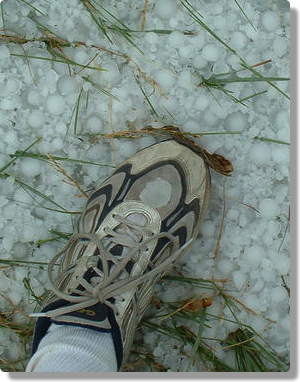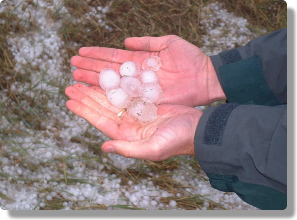
|

|


What happens inside a cloud?
Micro-scale Processes - Hail Hail is produced in cumulonimbus clouds and it grows by accumulating supercooled liquid droplets, also known as accretion. Hail often starts as graupel or large frozen raindrops. In the cold, high part
of a cloud, supercooled droplets can freeze directly onto a forming hailstone.
The freezing droplets trap air bubbles, and the resulting ice is milky or
opaque.
As the water freezes, heat is released. In regions of the cloud with higher
liquid water content, this can warm the hailstone enough to result in a coating
of water around it. If the hailstone moves back into a region with low liquid
water content, the surface water will cool, freeze and form clear ice. Also,
depending on the combination of updrafts, downdrafts, and lateral winds within
the cloud, the hailstone could develop a pattern of clear and milky ice as it
travels between regions of varying liquid water content.
Hail often starts as graupel or large frozen raindrops. In the cold, high part
of a cloud, supercooled droplets can freeze directly onto a forming hailstone.
The freezing droplets trap air bubbles, and the resulting ice is milky or
opaque.
As the water freezes, heat is released. In regions of the cloud with higher
liquid water content, this can warm the hailstone enough to result in a coating
of water around it. If the hailstone moves back into a region with low liquid
water content, the surface water will cool, freeze and form clear ice. Also,
depending on the combination of updrafts, downdrafts, and lateral winds within
the cloud, the hailstone could develop a pattern of clear and milky ice as it
travels between regions of varying liquid water content.
 Depending on how long a hailstone is in a cloud, it can grow up to the size of
a baseball, although it will shrink on its journey from the cloud to the ground.
In order for a golf-ball sized hailstone to form, it takes about 10 billion
cloud droplets and about 5 to 10 minutes within the cloud. Therefore, clouds
with very strong updrafts are beneficial to hail growth. It is also helpful if
the updrafts are tilted, so the hailstones travel sideways through the cloud and
can encounter more liquid water.
Next page
->
Micro-scale processes - rain, hail or snow?
Links and resources
Depending on how long a hailstone is in a cloud, it can grow up to the size of
a baseball, although it will shrink on its journey from the cloud to the ground.
In order for a golf-ball sized hailstone to form, it takes about 10 billion
cloud droplets and about 5 to 10 minutes within the cloud. Therefore, clouds
with very strong updrafts are beneficial to hail growth. It is also helpful if
the updrafts are tilted, so the hailstones travel sideways through the cloud and
can encounter more liquid water.
Next page
->
Micro-scale processes - rain, hail or snow?
Links and resources
Micro-scale Processes - Hail Hail is produced in cumulonimbus clouds and it grows by accumulating supercooled liquid droplets, also known as accretion.
 Hail often starts as graupel or large frozen raindrops. In the cold, high part
of a cloud, supercooled droplets can freeze directly onto a forming hailstone.
The freezing droplets trap air bubbles, and the resulting ice is milky or
opaque.
As the water freezes, heat is released. In regions of the cloud with higher
liquid water content, this can warm the hailstone enough to result in a coating
of water around it. If the hailstone moves back into a region with low liquid
water content, the surface water will cool, freeze and form clear ice. Also,
depending on the combination of updrafts, downdrafts, and lateral winds within
the cloud, the hailstone could develop a pattern of clear and milky ice as it
travels between regions of varying liquid water content.
Hail often starts as graupel or large frozen raindrops. In the cold, high part
of a cloud, supercooled droplets can freeze directly onto a forming hailstone.
The freezing droplets trap air bubbles, and the resulting ice is milky or
opaque.
As the water freezes, heat is released. In regions of the cloud with higher
liquid water content, this can warm the hailstone enough to result in a coating
of water around it. If the hailstone moves back into a region with low liquid
water content, the surface water will cool, freeze and form clear ice. Also,
depending on the combination of updrafts, downdrafts, and lateral winds within
the cloud, the hailstone could develop a pattern of clear and milky ice as it
travels between regions of varying liquid water content.
 Depending on how long a hailstone is in a cloud, it can grow up to the size of
a baseball, although it will shrink on its journey from the cloud to the ground.
In order for a golf-ball sized hailstone to form, it takes about 10 billion
cloud droplets and about 5 to 10 minutes within the cloud. Therefore, clouds
with very strong updrafts are beneficial to hail growth. It is also helpful if
the updrafts are tilted, so the hailstones travel sideways through the cloud and
can encounter more liquid water.
Next page
->
Micro-scale processes - rain, hail or snow?
Links and resources
Depending on how long a hailstone is in a cloud, it can grow up to the size of
a baseball, although it will shrink on its journey from the cloud to the ground.
In order for a golf-ball sized hailstone to form, it takes about 10 billion
cloud droplets and about 5 to 10 minutes within the cloud. Therefore, clouds
with very strong updrafts are beneficial to hail growth. It is also helpful if
the updrafts are tilted, so the hailstones travel sideways through the cloud and
can encounter more liquid water.
Next page
->
Micro-scale processes - rain, hail or snow?
Links and resources
